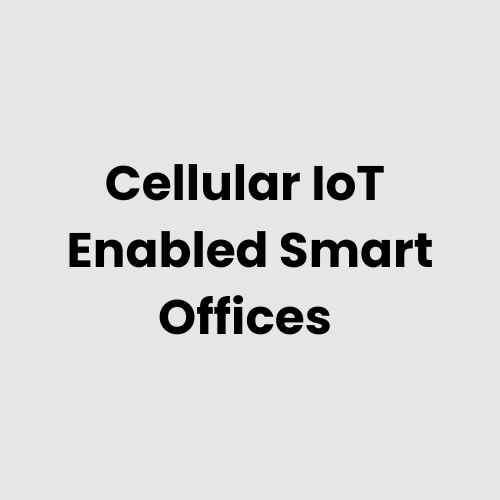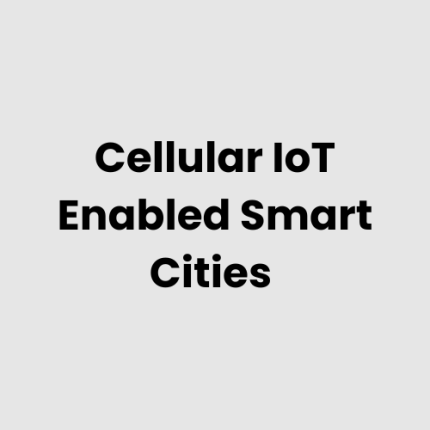Description
Technical Architecture of Cellular IoT Enabled Smart Offices
The Cellular IoT Enabled Smart Offices system features a multi-layered architecture designed for seamless office automation. Key components include:
- IoT Device Layer: A network of interconnected IoT devices, including sensors, actuators, and wearables, collects and transmits real-time office data.
- Gateway Layer: Cellular gateways ensure reliable communication between IoT devices and the cloud or local servers.
- Edge Computing: Integrated edge processors provide low-latency responses for time-sensitive applications.
- Cloud/Local Server Layer: Handles data processing, analytics, and storage, offering scalability and redundancy.
This architecture ensures a high degree of flexibility, allowing offices to adapt to dynamic demands while maintaining energy efficiency and operational reliability.
Hardware of Cellular IoT Enabled Smart Offices
Key hardware components include:
- Smart IoT Sensors: For monitoring environmental parameters like temperature, humidity, and occupancy.
- Cellular IoT Gateways: Enabling connectivity with robust data transmission capabilities.
- Smart Lighting Controls: For automated lighting based on occupancy and time schedules.
- Wearable IoT Devices: Providing seamless interaction with office systems.
- Remote Monitoring Systems: To ensure efficient surveillance and security.
- Data Servers: For centralized data processing and backup.
Physical Placement Considerations
To optimize functionality:
- Sensors: Installed in strategic locations for accurate monitoring of environmental conditions.
- Gateways: Placed centrally within the office to maximize communication range and reduce latency.
- Lighting Controls: Distributed across workspaces for efficient energy use.
- Servers: Stored in secure, temperature-controlled server rooms with proper power backup systems.
- Wearables: Designed to be ergonomic and easy to carry by employees for seamless interaction with office systems.
Hardware Architecture
The hardware architecture of Cellular IoT Enabled Smart Offices integrates the following:
- IoT Endpoints: Sensors and actuators deployed across the office environment.
- Edge Devices: Processing units with built-in cellular connectivity for real-time data computation.
- Gateways: Bridging local IoT networks with cloud or local server infrastructure.
- Cloud Integration: Back-end support for scalable analytics and storage.
Deployment Considerations
GAO Tek ensures smooth deployment by addressing:
- Scalability: Supporting offices of varying sizes with modular components.
- Data Security: Adhering to strict encryption and privacy standards.
- Interoperability: Seamless integration with existing office systems and platforms.
- Environmental Factors: Hardware designed to operate efficiently in diverse office conditions.
- Remote and Onsite Support: Expert guidance during setup and ongoing maintenance.
Relevant Industry Standards and Regulations
- IEEE 802.15.4
- 3GPP Standards
- ISO 9001
- ISO/IEC 27001
- GDPR
- NIST Cybersecurity Framework
- FCC Regulations
Local Server Version
For organizations requiring enhanced data security, GAO Tek provides a local server version of the system. This configuration allows:
- Full control and ownership of data.
- Low-latency performance for mission-critical tasks.
- Enhanced compliance with strict data sovereignty regulations.
- Seamless integration with existing IT infrastructure.
Cloud Integration and Data Management
The cloud-enabled version of Cellular IoT Enabled Smart Offices ensures:
- Real-Time Analytics: Leveraging cloud computing for actionable insights.
- Scalable Storage: Effortless management of expanding data volumes.
- Data Redundancy: Automatic backups to prevent loss of critical information.
- AI-Driven Insights: Predictive analysis for resource optimization and proactive decision-making.
Partnering with GAO Tek means gaining access to advanced cloud-based solutions designed to streamline office operations and drive productivity.
GAO Case Studies of Cellular IoT Enabled Smart Offices
- New York City, USA
A major corporate office in New York City implemented cellular IoT technology to optimize energy consumption across its facilities. By using IoT sensors to track temperature, lighting, and occupancy, the building achieved significant energy savings and enhanced overall efficiency, creating a more sustainable work environment.
- San Francisco, USA
In San Francisco, a tech company employed cellular IoT devices to improve workplace safety. IoT-enabled smart sensors monitored air quality, CO2 levels, and potential hazards, allowing the company to take immediate corrective actions, ensuring a healthier work environment and compliance with safety regulations.
- Chicago, USA
Chicago’s office buildings adopted cellular IoT systems to manage space utilization and enhance employee productivity. Sensors detected occupancy patterns and adjusted lighting and HVAC systems in real time, creating a more comfortable and energy-efficient workplace while also optimizing space usage.
- Los Angeles, USA
A large office complex in Los Angeles integrated cellular IoT to automate and manage its security systems. The IoT-enabled solution provided real-time monitoring of entry points, surveillance cameras, and access control, ensuring enhanced security and faster response times to incidents.
- Houston, USA
In Houston, a leading corporation installed cellular IoT devices for real-time monitoring of office equipment, including printers and copiers. This solution allowed the company to track equipment health and usage, reducing maintenance costs and minimizing downtime, ultimately increasing operational efficiency.
- Miami, USA
A corporate office in Miami used cellular IoT sensors to monitor environmental conditions, such as humidity and temperature, in sensitive areas. The data from these sensors allowed for proactive management of office equipment, reducing the risk of damage and ensuring optimal operational performance.
- Seattle, USA
Seattle’s business district saw the implementation of a cellular IoT system to track and manage indoor air quality. By integrating IoT-enabled sensors, office managers were able to ensure that air circulation systems were functioning optimally, improving employee well-being and meeting environmental standards.
- Dallas, USA
In Dallas, a prominent tech company adopted cellular IoT technology to enhance its conference room management. The system tracked meeting room availability and usage, automatically adjusting lighting and temperature settings, and providing real-time updates on room booking status, improving overall meeting efficiency.
- Atlanta, USA
Atlanta’s office buildings integrated cellular IoT devices to streamline the management of their HVAC systems. Sensors provided real-time data on temperature and air quality, allowing for more precise control of the environment, ensuring employee comfort while reducing energy consumption.
- Washington, D.C., USA
A large office complex in Washington, D.C. deployed cellular IoT devices to monitor lighting efficiency. The system adjusted the lighting based on occupancy, daylight, and time of day, contributing to a significant reduction in energy costs while maintaining optimal lighting conditions for employees.
- Boston, USA
In Boston, a corporate office used cellular IoT to track and manage the status of office equipment. Sensors detected malfunctions or when maintenance was required, which enabled the company to schedule repairs proactively, minimizing disruptions to workflow and reducing repair costs.
- Denver, USA
Denver’s office environments utilized cellular IoT technology to enhance facility management. The solution monitored the use of utilities like water and electricity, alerting the building management team to inefficiencies or leaks, which were then addressed to prevent wastage and reduce operational costs.
- Phoenix, USA
A high-rise office building in Phoenix integrated cellular IoT sensors to monitor the condition of its elevators. This allowed real-time tracking of performance and proactive maintenance, ensuring the safety and reliability of the elevator system, while also reducing unplanned downtimes and repair costs.
- Minneapolis, USA
In Minneapolis, a corporate office used cellular IoT technology to streamline its asset management system. Sensors tracked valuable office equipment, including computers and projectors, ensuring real-time visibility on asset status and preventing loss or misuse, optimizing operational efficiency.
- Detroit, USA
Detroit’s corporate sector saw the integration of cellular IoT solutions to manage employee workspaces. By using IoT sensors to monitor desk occupancy and space usage, the company was able to optimize its office layout, ensuring that resources were efficiently allocated while minimizing wasted space.
- Toronto, Canada
A large financial institution in Toronto implemented cellular IoT to manage its office energy systems. By using IoT-enabled devices to monitor energy usage patterns, the company was able to automate energy savings based on occupancy and building usage, helping to significantly lower operational costs while improving sustainability.
- Vancouver, Canada
In Vancouver, a commercial building deployed cellular IoT technology to track air quality and adjust the HVAC system accordingly. The solution ensured that employees were breathing fresh air at all times, improving both their comfort and productivity, while maintaining energy efficiency.
At GAO Tek Inc., headquartered in New York City and Toronto, Canada, we specialize in providing cutting-edge IoT solutions for smart office environments. Our systems offer real-time monitoring, predictive analytics, and enhanced operational efficiency, helping businesses optimize resource usage and improve employee well-being. With over four decades of experience and a commitment to R&D, GAO Tek is a trusted partner in delivering high-quality, reliable IoT solutions for a range of applications. Explore our cellular IoT devices and smart office solutions to learn more.
Navigation Menu for Cellular IoT
Navigation Menu for IoT
Our products are in stock and can be shipped anywhere in the continental U.S. or Canada from our local warehouse. For any further information, please fill out this form or email us.
We are looking for partners. For more information on partnering with GAO, please visit Partner with GAO Tek Inc. It lists various ways to partner with GAO, such as OEM Partnerships, Technology Integration, Distribution and Reselling Opportunities, Presenting at the Leading Event Tek Summit, Joint R&D Projects, Training and Consulting Services, Industry-Specific Collaborations, Research and Academic Partnerships.



